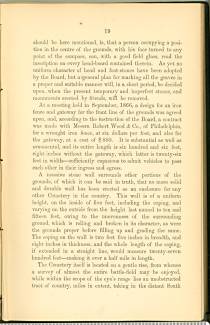Collection Name
About
should be here mentioned, is, that a person occupying a position in the centre of the grounds, with his face turned to any point of the compass, can, with a good field glass, read the inscription on every head-board contained therein. As yet no uniform character of head and foot-stones have been adopted by the Board, but a general plan for marking all the graves in a proper and suitable manner will, in a short period, be decided upon, when the present temporary and imperfect stones, and monuments erected by friends, will be removed.
At a meeting held in September, 1866, a design for an iron fence and gateway for the front line of the grounds was agreed upon, and, according to the instruction of the Board, a contract was made with Messrs. Robert Wood & Co., of Philadelphia, for a wrought iron fence, at six dollars per foot, and also for the gateway, at a cost of $ 880. It is substantial as well as ornamental, and its entire length is six hundred and six feet, eight inches without the gateway, which latter is twenty-six feet in width—-sufficiently capacious to admit vehicles to pass each other in their ingress and egress.
A massive stone wall surrounds other portions of the grounds, of which it can be said in truth, that no more solid and durable wall has been erected as an enclosure for any other Cemetery in the country. This wall is of a uniform height, on the inside of five feet, including the coping, and varying on the outside from the height last named to ten and fifteen feet, owing to the unevenness of the surrounding ground, which is rolling and broken in its character, as were the grounds proper before filling up and grading the same. The coping on the wall is two feet five inches in breadth, and eight inches in thickness, and the whole length of the coping, if extended in a straight line, would measure twenty-seven hundred feet—making it over a half mile in length.
The Cemetery itself is located on a gentle rise, from whence a survey of almost the entire battle-field may be enjoyed, while within the scope of the eye's range lies an unobstructed tract of country, miles in extent, taking in the distant South
